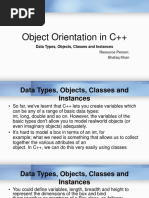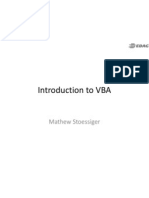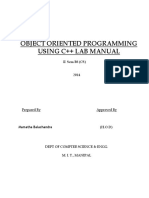Assignment 2
Uploaded by
Mikhail VAssignment 2
Uploaded by
Mikhail VCS 115: Object-Oriented Design
Assignment No. 2
Deadline: As specified on UR Courses
Total Marks: 20
Instructions:
• Make sure that you read and understand each instruction.
• The assignment contains a single problem divided into three subtasks.
• Write all your code in a single .cpp file.
• Name the .cpp file as IDNumber.zip (e.g., 200449669.zip).
• Submit the .cpp file on UR Courses within the deadline.
• Start early otherwise you will struggle with the assignment.
• Not following instructions will result in deduction of marks.
• Write your own solutions. A copied solution will result in a zero mark for both parties
involved.
1. Write a class named Distance with the following specifications:
• Two data members: feet(int) and inches(float)
• Two overloaded constructors: one that takes no argument and the other that takes two
arguments. Zero argument constructor initializes data members from 0 whereas two
argument constructor initializes data members from the passed arguments.
• Two getters and two setters corresponding to two data members.
• A member function named toDecimal that converts a distance to decimal, e.g., if a
distance equals 2 feet and 6 inches then it would become 2.5 in decimal.
• A member function named toString that returns a string representation of a distance,
e.g., if a distance equals 2 feet and 6 inches then the corresponding string
representation should be 2’-6”.
2. Write a class named Box with the following specifications:
• Three data members: length, width, and height. All data members are of type Distance.
• Two overloaded constructors: one that takes no argument and the other that takes
three arguments. Zero argument constructor initializes data members from 0 whereas
three argument constructor initializes data members from the passed arguments. At
least one of the constructors should use an initializer list.
• A copy constructor.
• Three getters and three setters corresponding to three data members.
• A member function named volume that returns the volume of a Box object, i.e.,
length*width*height.
• Three member functions named greaterThan, lessThan and equalTo to compare two Box
objects based on their volume. Each function must return a Boolean value.
• A static data member count(int) which is used to count Box objects active at any time.
• A getter for count.
• The class must contain a few constant functions (decide which of the above functions
are good candidates for that)
3. In your main program:
• Create 4 Box objects (at least one should be created using copy constructor).
• Display number of boxes in the program.
• Display dimensions of all boxes.
• Display whether any of those boxes are equal in volume.
• Display dimensions of the largest box.
• Display dimensions of the smallest box.
• Allow one or more boxes to go out of scope (end their lifetime) and display the
remaining boxes.
A sample output of main program is shown below:
There are 4 Boxes in this program.
Box 1 dimensions: length = 5'-3", width = 2'-7.5", height = 3'-8" and volume = 50.53125
Box 2 dimensions: length = 4'-6", width = 9'-3", height = 2'-4" and volume = 97.125
Box 3 dimensions: length = 4'-6", width = 9'-3", height = 2'-4" and volume = 97.125
Box 4 dimensions: length = 3'-3", width = 9'-3", height = 2'-4" and volume = 70.145828
Box 2 and Box 3 are equal.
The largest box has dimensions: length = 4'-6", width = 9'-3", height = 2'-4" and volume = 97.125
The smallest box has dimensions: length = 5'-3", width = 2'-7.5", height = 3'-8" and volume = 50.53125
Now there are 2 Boxes left in this program.
Your code should have the following validity checks:
• Feet or inches can not be negative.
• Inches cannot be greater than or equal to 12.
• A single dimension of a box cannot exceed 1000 feet.
Apply these checks in constructors as well as setters.
Marks Distribution:
Marks
Distance class, its data members and member functions 4
Box class, its data members and member functions 8
Main function and its code 4
Validity checks 2
Code organization and readability 2
Total 20
You might also like
- Punjab Group of Colleges: Intro To Computer Science (C++) Assignment No.01No ratings yetPunjab Group of Colleges: Intro To Computer Science (C++) Assignment No.015 pages
- Lecture - 02 - Object Orientation in C++No ratings yetLecture - 02 - Object Orientation in C++17 pages
- Data Structures: Introduction and Necessary BackgroundNo ratings yetData Structures: Introduction and Necessary Background31 pages
- Assignment 3:: Due 8am On Mon, Oct 28, 2019No ratings yetAssignment 3:: Due 8am On Mon, Oct 28, 201910 pages
- FINAL EXAMINATION OF Object Oriented Progra,,ing C++No ratings yetFINAL EXAMINATION OF Object Oriented Progra,,ing C++8 pages
- Cse2001 Object-Oriented-programming-with-c++ LTP 1.1 58 Cse2001 Object Oriented Programming With C++ LTP 4 v1.1No ratings yetCse2001 Object-Oriented-programming-with-c++ LTP 1.1 58 Cse2001 Object Oriented Programming With C++ LTP 4 v1.13 pages
- Integers, Floats, and Strings: Session #2No ratings yetIntegers, Floats, and Strings: Session #224 pages
- Data Structure & Algorithm: Programming StrategiesNo ratings yetData Structure & Algorithm: Programming Strategies80 pages
- Microsoft Visual Basic Interview Questions: Microsoft VB Certification ReviewFrom EverandMicrosoft Visual Basic Interview Questions: Microsoft VB Certification ReviewNo ratings yet
- Python Advanced Programming: The Guide to Learn Python Programming. Reference with Exercises and Samples About Dynamical Programming, Multithreading, Multiprocessing, Debugging, Testing and MoreFrom EverandPython Advanced Programming: The Guide to Learn Python Programming. Reference with Exercises and Samples About Dynamical Programming, Multithreading, Multiprocessing, Debugging, Testing and MoreNo ratings yet
- Mastering Go A Practical Guide to Developers: A Practical Guide to DevelopersFrom EverandMastering Go A Practical Guide to Developers: A Practical Guide to DevelopersMiguel Miranda de MattosNo ratings yet
- Introduction to Python Programming: Do your first steps into programming with pythonFrom EverandIntroduction to Python Programming: Do your first steps into programming with pythonNo ratings yet
- C# Interview Questions, Answers, and Explanations: C Sharp Certification ReviewFrom EverandC# Interview Questions, Answers, and Explanations: C Sharp Certification Review4.5/5 (3)
- Electric Drive Ebjc Ebja Ebra Ebjd Repair Manual EngNo ratings yetElectric Drive Ebjc Ebja Ebra Ebjd Repair Manual Eng283 pages
- 365B L Your Working Advantage (AEDC0603-01)100% (1)365B L Your Working Advantage (AEDC0603-01)16 pages
- Control Systems Laboratory: Analogue ComputerNo ratings yetControl Systems Laboratory: Analogue Computer11 pages
- Complete Download (Ebook) Fundamentals of Meteorology by Vlado Spiridonov, Mladjen Ćurić ISBN 9783030526542, 9783030526559, 3030526542, 3030526550 PDF All Chapters100% (8)Complete Download (Ebook) Fundamentals of Meteorology by Vlado Spiridonov, Mladjen Ćurić ISBN 9783030526542, 9783030526559, 3030526542, 3030526550 PDF All Chapters65 pages
- Grammar Task 1. Fill in The Gaps With Appropriate Question Words100% (1)Grammar Task 1. Fill in The Gaps With Appropriate Question Words3 pages
- Microstation V8 2004 Edition: Pattern/Graphics IssueNo ratings yetMicrostation V8 2004 Edition: Pattern/Graphics Issue7 pages
- Unit 3: Capacity Requirement Planning (CRP)No ratings yetUnit 3: Capacity Requirement Planning (CRP)25 pages
- (Ebook) Linear Feedback Control: Analysis and Design with MATLAB (Advances in Design and Control) by Dingyu Xue, YangQuan Chen, Derek P. Atherton ISBN 9780898716382, 0898716381 - The full ebook with all chapters is available for download100% (1)(Ebook) Linear Feedback Control: Analysis and Design with MATLAB (Advances in Design and Control) by Dingyu Xue, YangQuan Chen, Derek P. Atherton ISBN 9780898716382, 0898716381 - The full ebook with all chapters is available for download59 pages
- CS 1000/CS 3000 HIS Operation: IM 33S02C10-01E 13th EditionNo ratings yetCS 1000/CS 3000 HIS Operation: IM 33S02C10-01E 13th Edition84 pages
- Acoustical Board Product Data Sheet: DescriptionNo ratings yetAcoustical Board Product Data Sheet: Description2 pages
- Potential Liquefaction of Locations Along The Pasig City Segment of The Valley Fault SystemNo ratings yetPotential Liquefaction of Locations Along The Pasig City Segment of The Valley Fault System87 pages
- The Specifications of DH9920C: Details PDFNo ratings yetThe Specifications of DH9920C: Details PDF1 page
- Energies: A New Power Sharing Scheme of Multiple Microgrids and An Iterative Pairing-Based Scheduling MethodNo ratings yetEnergies: A New Power Sharing Scheme of Multiple Microgrids and An Iterative Pairing-Based Scheduling Method20 pages

























































































